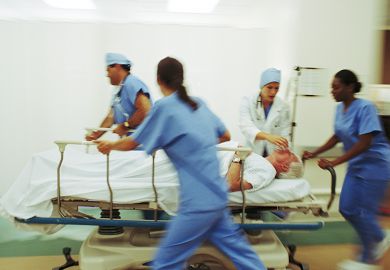Two and a half decades ago, in my first full year in the day job, I am on the Euston Road in London. Half a mile away, 17 universities are meeting in the Russell Hotel.
Edge Hill did not qualify for university title in the early 1990s. Although it had recently merged with three schools of nursing and midwifery, it was, at best, what estate agents euphemistically call a “development opportunity”.
In 2006 it acquired full university status, and this week it was granted one of the five new medical schools.
The NHS is in difficulty. Unwise cuts in commissions early in the coalition government years have been compounded by budgetary shortages, the need for safe staffing levels and policy changes that are making the UK a less attractive destination for professionals from overseas.
In response, the cap has been lifted on nursing recruitment, although negative perceptions of the new tuition fee regime are stifling demand for less popular programmes, and last year the secretary of state announced plans to recruit 1,500 additional trainee doctors.
The first 500 places were allocated in the autumn to existing medical schools, and every such school has also participated successfully in the second bidding round, taking up a further 590 places.
But just over 400 places have been allocated to five new schools. Partnership arrangements between the universities of Nottingham and Lincoln and between Kent and Canterbury Christ Church have been rewarded with just under half of this number, with three new free-standing schools being approved, in Chelmsford, Sunderland and, smallest of all…Ormskirk.
Geographically disparate, the three new schools all have something in common: resonance with the Department of Health’s clearly expressed commitment to widen participation in medical education.
Edge Hill University was founded in the 1880s with a mission to provide access to higher education, and it has sought to remain true to that vision for the past 130 years, working closely with schools and colleges as the regional lead for Aim Higher, the sponsor of the local lifelong learning network and the national host of Action on Access.
To twin-track excellence and accessibility has not always been easy, but the prize is worth fighting for. It is half a century since we pioneered innovative programmes that qualified graduates as both teachers and nurses of children with learning disabilities, and today we train individuals to qualify both as nurses and social workers, recruiting heavily from Merseyside, the overspill estates and the former mill and mining towns of the north west.
This integration is important to us. Hospitals and communities operate better when individuals bring skill sets, and parity of esteem, and work together in teams. The challenges in our region are substantial; my office is on the outskirts of one town and four miles from another. The difference in average life expectancy between the two, just 10 minutes’ drive away, is 10 years.
This also influences what our new medical school will do. We have eschewed the opportunity to start before 2020 because we intend to start in other ways before 2020; we begin today, raising awareness and ambition with Year 9, 10 and 11 pupils in schools and colleges in less privileged parts of the region, offering a foundation programme in 2019 for those with less conventional qualifications, before taking our first intake of medical undergraduates the following year.
Our specialisms will be different, too. While covering the full curriculum, we will have a particular focus on general practice, on primary care, health promotion, nutrition, psychiatry, palliative care, on the ability to treat patients at home not in hospital, and to help prevent preventable ills.
And we want our locally trained doctors to return to and work in local communities, communities where recruiting trained medics is challenging but where the healthcare needs are greatest.
Will it be tough? You bet. Will it cost us money? It will, as we invest in new staff, new equipment and a brand-new clinical skills centre, as well as outreach facilities in our hospitals and our community.
We are starting small, making sure that we get it right, but building on our experience in providing master’s of surgery and master’s of medicine postgraduate programmes for qualified doctors over the past decade.
Should we be doing it? Undoubtedly. Of course the perceived reputational benefits matter, but the fit is right – clinicians alongside our trainee nurses and midwives, social workers and nutritionists, paramedics and operating theatre staff.
More important, the fit is right ideologically, too. Universities have had a bad press over the past year, but we are here to improve life chances and to educate and train those who can improve others’ life chances.
A community-focused medical school on the fringes of areas of multiple deprivation is a wonderful opportunity to take that commitment, that ideology, and put it into practice.
John Cater is the vice-chancellor of Edge Hill University.
Register to continue
Why register?
- Registration is free and only takes a moment
- Once registered, you can read 3 articles a month
- Sign up for our newsletter
Subscribe
Or subscribe for unlimited access to:
- Unlimited access to news, views, insights & reviews
- Digital editions
- Digital access to THE’s university and college rankings analysis
Already registered or a current subscriber?






